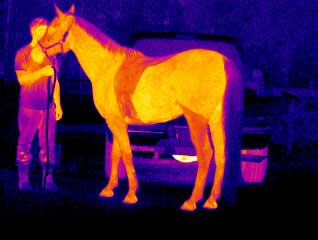Best Infrared Cameras for Veterinary and Equine Thermography
The equine world has been plagued by soft tissue ( muscles, hoof, ligaments, cartilage, and vertebral. ) damage since there have been people and horses. In the past most of these injury’s cost owners significant stress and financial resources as well as the destruction of many valuable animals. The hallmark of most soft tissue problems is inflammation. Inflammation is always signified by heat. Thermal infrared cameras offer the world of equine medicine an amazing non-invasive tool that detects subtle variations in heat and provides the operator with high resolution images and detailed reports pin pointing problem areas in your animal. You now have the ability to see inflammation much earlier than you ever could have detected it before.
You can treat your horse in the crucial early stage of injury preventing serious problems or even death and saving you stress, time, and money.

A thermal image of a horse from one of our infrared cameras. Hot spots can hint to swelling, infection or pain long before the animal exhibits symptoms. The technique is completely non-invasive to contribute to the overall health of the animal.
- General health diagnostics
- Lameness detection
- Wound assessment
- Infrared equine dental diagnosing
- Localized inflammation detection
- Reproduction applications
Thermal infrared cameras are not only valuable diagnostic tools for equine medicine they offer a multitude of uses to the horse industry. Veterinarians can use infrared cameras to detect injuries such as hoof abscesses, vertebral, muscle, ligament, tendon, long bone injuries, joint diseases, and other inflammations that can have dire effects. You can detect many of these problems up to two weeks before traditional clinical signs are evident. The horse can be treated before lameness occurs because lameness is just a symptom of an underlying problem that you can detect with an infrared camera.
Horse trainers can use data from this valuable tool to evaluate many aspects of their training program. IR images can help you maintain proper hoof balance before you develop problems such as abscesses or navicular. IR cameras can help you achieve perfect saddle fit. Thermal imagers provide you with data on muscle inflammation before, during, and after a workout. You now have scientific data indicating when to work your horse, when to rest your animal, and just how hard you can push without causing injury. Use the thermal imager as part of your pre race / show check. Find out if your horse is fit for competition before that gut wrenching, slow motion, head over hoof disaster occurs.
Horse buyers can use thermal infrared imaging cameras as a pre purchase contingency test. You will know without a doubt if the prospective horse is sound. You can pinpoint problem areas and show the seller physical evidence allowing you to adjust your offer appropriately or pass on the purchase. This ability alone can save you many times the cost of a good thermal infrared system.

Infrared cameras provide an option of diagnosis without sedation, which in itself can be dangerous to the animal’s health.
Applications for thermography include diagnosing tendinitis, following tendon healing, and viewing muscle injury, muscle atrophy, and muscle strain. Additional uses include the detection of laminitis and abscesses in the foot and the diagnosis of capsulitis/synovitis in the joints. After a problem is discovered, a veterinarian typically will assess the injury further using X rays, ultrasound, scintigraphy (nuclear imaging), and other tools
Horse sellers can advertise their animal as being sound and provide the buyer with hard scientific evidence. This is a powerful tool allowing you to maximize the full potential of your investment. Ranchers and livestock owners can track their animals day or night ( even in pitch darkness ). If you have a large property with animals roaming a thermal infrared camera will allow you to pinpoint and recover strays from considerable distance. In addition, those pesky varmints and predators can be spotted and dealt with before they cause you damage.
Thermal infrared cameras come in many configurations to suit a variety of applications. There are many factors in deciding which imager is appropriate for a particular application. Military law enforcement type imagers are generally small portable devices that provide a detailed gray scale image. These are not the preferred units for equine medicine. Industrial and scientific imagers generally have color output and can range from portable handheld units to larger multiple piece systems. These are the imagers you want, and the best infrared cameras for the task.
The main points to consider when shopping for a color output thermal infrared camera are price, portability, and type of detector. The ideal package would be a state of the art, reasonably priced, handheld imager with an uncooled detector. Some units use a gas (nitrogen) to cool the detector. The gas needs to be periodically recharged. The benefits of older “cooled” systems are low pricing and good image quality for the money. Demo uncooled units are available. These units are appropriate for equine use and offer a low cost, low maintenance thermal infrared solution. The drawback of these units is that they are generally larger in size. Older uncooled units would be the best infrared cameras for starting a thermal infrared program on a budget.
For more information on the best infrared cameras for veterinary care that SPI Corp offers, please contact us, or call Jim Santana at (702) 369-3966 in the Las Vegas area, or toll free at (800) 403-2983.
